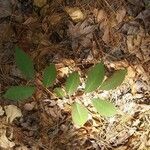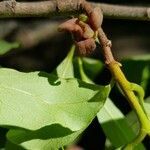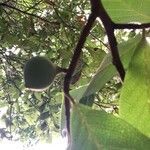Shrubs or low trees , to 6 m; trunks slender, at most to 10 cm diam. Branches spreading-ascending, slender; new shoots red-brown, distally minutely reddish tomentose. Leaves: petiole 5-10 mm. Leaf blade obovate to oblanceolate, 6-15(-20) cm, membranous, rarely leathery, base narrowly to broadly cuneate, margins barely revolute, apex acute to acuminate; surfaces abaxially minutely rusty-tomentose, aging hairy on veins only, adaxially puberulent on veins, aging glabrous. Inflorescences from previous year's shoots before or during new leaf emergence; peduncle 0.3-0.8 cm, tomentose, hairs red-brown to tan; bracteoles 1(-2), basal, usually ovate-triangular, rarely over 2-3 mm, hairy. Flowers maroon, rarely yellow, faintly fetid, 1-1.7 cm diam.; sepals triangular-deltate, 4-7 mm, abaxially rusty-tomentose; outer petals oblong to ovate, 1-1. 3cm, apex excurved, lingulate, surfaces abaxially minutely rusty-tomentose; inner petals ovate, ca. 1/2 length of outer petals, base saccate, apex strongly recurved, veins adaxially incised, corrugate nectary zone indistinct or absent; pistils 5-7. Berries greenish yellow, 3-6(-7) cm. Seeds chestnut brown, 1-1.5(-2) cm. 2 n =18.
More
Much like no. 1 [Asimina triloba (L.) Dunal]; shrub to 4 m; lvs 6–15(–20) cm after anthesis; fls 12–15 mm wide, the sep 4–7 mm long, the outer pet 1–1.3 cm; peduncles 3–8 mm at anthesis; frs 2–6 cm; seeds 1–1.5 cm; 2n=18. Pine or oak woods on the coastal plain and less frequently on the piedmont; se. Va. to n. Fla., w. to e. Tex. Apr.







